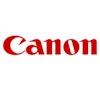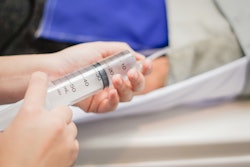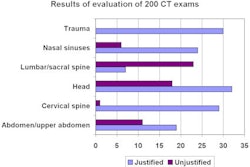A study of contrast CT exams performed on more than 12,000 children has revealed that the risk of reactions to nonionic intravenous contrast material is exceedingly low and the reactions themselves are mild.
Researchers at Children's Hospital Boston in Massachusetts suggested that appropriate use of intravenous contrast in children for medically indicated exams will potentially decrease overall radiation exposure by reducing the number of unenhanced CT exams that ultimately need to be repeated with contrast.
Pediatric radiologist Dr. Michael J. Callahan and colleagues reviewed the records of all patients who received nonionic low-osmolarity contrast material for CT exams and urographic studies at Children's Hospital Boston over a seven-year period from 1999 through 2005. They determined that the odds of a pediatric patient developing a mild or moderate reaction from contrast material were one in 200.
The study found no incidence of serious reactions, and no reactions whatsoever were reported for urographic studies. The findings were published in the March issue of Radiology (2009, Vol. 250:3, pp. 674-681).
The objective of the study was to examine the incidence and severity of reactions to nonionic intravenous contrast material in a large pediatric and young adult population, and to identify potential risk factors associated with any adverse event. The study of 12,494 consecutive patients was evenly balanced by sex (52.8% male, 47.2% female), and representatively balanced by age.
There were 11,553 patients who received CT exams and 941 patients who had excretory urography studies. Although a total of 19,756 procedures were performed during this time, only the first exam was counted.
The dose for the contrast material was based on body weight, at 1.5-2.0 mL/kg. The maximum dose for any patient was 2.0 mL/kg, and ioversol (Optiray 320, Covidien, Hazelwood, MO) was exclusively used.
A total of 57 adverse events were attributed to contrast administration. Eighty-two percent of the adverse events were classified as mild, with symptoms including nausea, altered taste, anxiety, or a warm sensation. The remaining 18% were moderate, with reported symptoms of wheezing, dyspnea, pronounced cutaneous reaction, hypertension, and/or age-appropriate tachycardia or bradycardia.
The patients who experienced contrast reactions ranged in age from 3.5 years to almost 21 years. Twenty-three of the 47 patients who had mild reactions were 10 to 15 years old, and five of the 10 patients who had moderate reactions were 16 to 18 years old. Patients younger than 7 years had mild reactions only, and no reactions at all were recorded for patients younger than 1 year.
Only three of the patients who had adverse reactions had a prior history of asthma, and all of these patients experienced moderate reactions. The best method for treating children with a history of asthma isn't clear, the authors stated, noting that the efficacy of premedication prior to administering intravenous contrast material for children with a history of asthma and allergies is controversial.
Although the number of mild reactions to contrast material may be underestimated among children less than 5 years of age because of an inability to verbalize their symptoms, Callahan and colleagues believe that the study verifies the safety of using nonionic contrast media and recommend its use for pediatric imaging when there is a diagnostic benefit.
By Cynthia E. Keen
AuntMinnie.com staff writer
February 25, 2009
Related Reading
Study: Follow guidelines when treating contrast reactions, August 4, 2008
Reaction to contrast agents may occur despite premedication, February 28, 2008
Part III: Imaging the pediatric patient: the use of CT in pediatric imaging, May 7, 2004
Blueberry juice enhances pediatric MR urography, April 26, 2001
Copyright © 2009 AuntMinnie.com




















